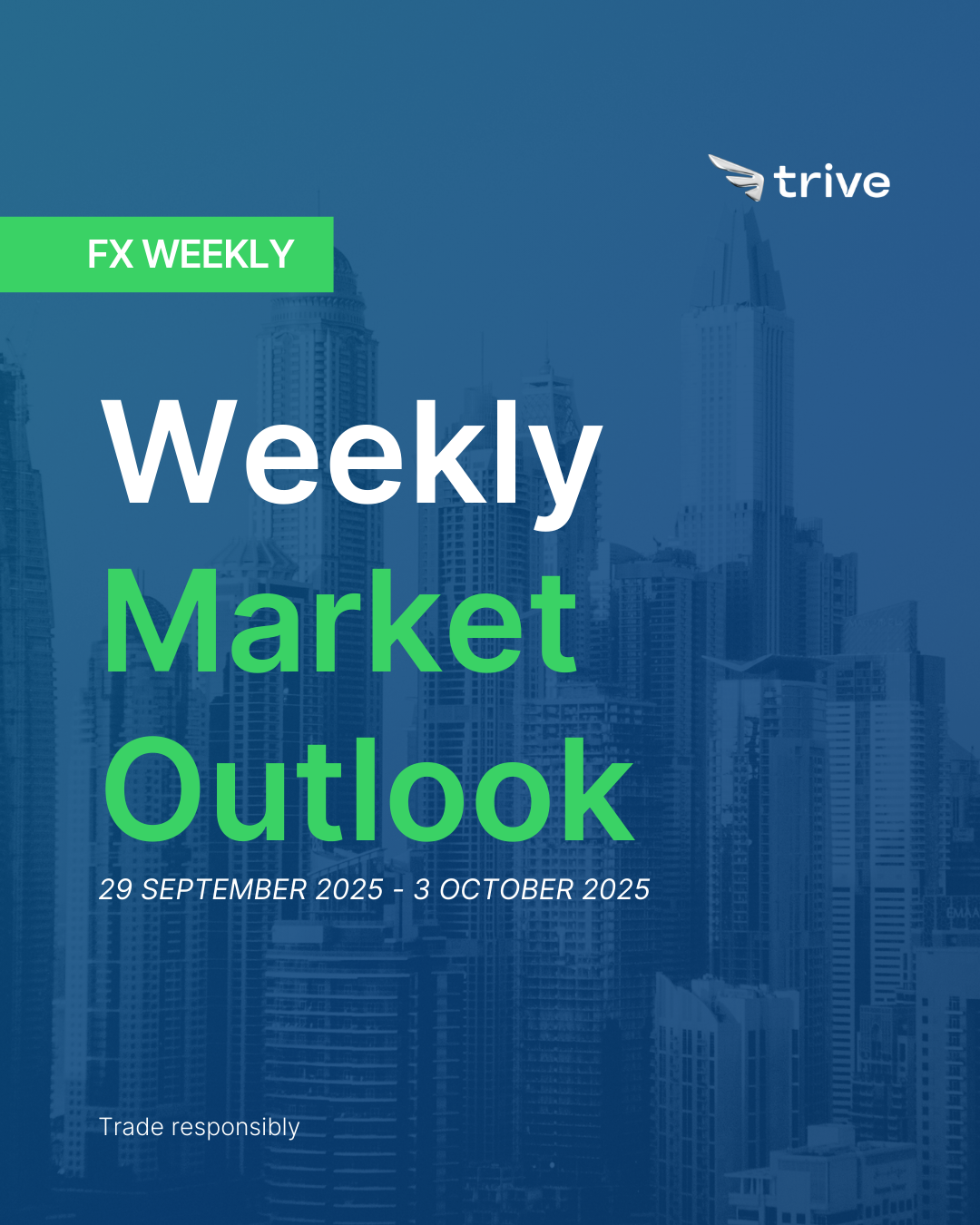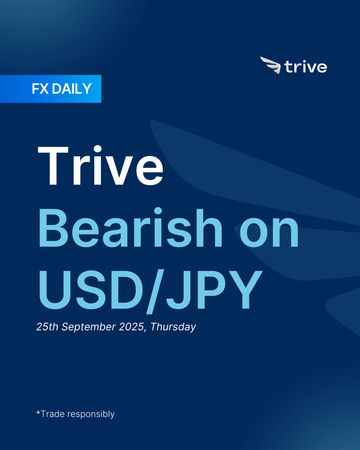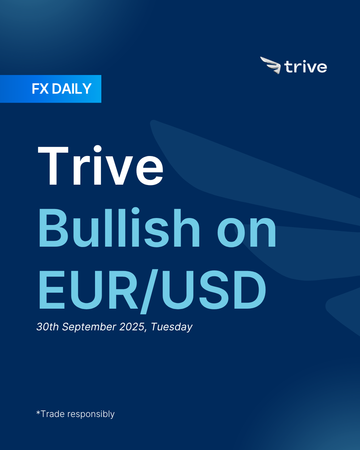FX Weekly: Trive’s Week Ahead Views

This week highlights include RBA Meeting, Eurozone Inflation and the most important US Labor Market Data.
Tuesday
The Reserve Bank of Australia is widely expected to leave the Cash Rate unchanged at 3.60% at its September 30 meeting. Markets currently price a 93% probability of no change and a 7% chance of a cut, with the next 25bps cut not fully priced until March 2026. This meeting will not include updated forecasts.
Analysts note that the upside surprise in August’s monthly CPI (3.0% Y/Y vs 2.8% prior) has reduced the urgency for near-term easing, though the trimmed mean eased slightly to 2.6% from 2.7%. Westpac still expects a 25bps rate cut in November, but concedes that the timing is now less certain, emphasising the RBA is unlikely to overreact to one month of stronger data given the broader inflation outlook remains consistent with the target.
With inflation around target and the labour market gradually loosening, the desk argues that policy need not remain restrictive for long. Meanwhile, Standard Chartered expects policymakers to maintain a wait-and-see approach ahead of the Q3 CPI release on October 29, which Governor Bullock has highlighted as a key input for future policy decisions.
Wednesday
September Eurozone HICP is expected to rise to 2.2% Y/Y from 2.0%, while the super-core metric is forecast to remain steady at 2.3% Y/Y.
In the previous report, the headline print held at 2.0% Y/Y, the super-core stayed at 2.3%, and the services metric eased to 3.1% Y/Y from 3.2%. Overall, the data signaled that Eurozone inflation was stabilising, with the headline measure at target for a third consecutive month.
This time, Investec, in line with consensus, anticipates a “temporary” departure from target driven by volatile elements rather than a shift in the underlying trend. The desk highlights that energy prices are likely to push inflation higher, given a smaller fall in fuel prices compared to a year ago. Similarly, services prices may record a temporary uptick tied to tourism-related costs.
That said, underlying price pressures are expected to remain consistent with those observed in the August report. From a policy perspective, the release is unlikely to influence the ECB, which is expected to stay on hold in the near term unless there is a marked deterioration in Eurozone growth. Market pricing reflects this view, with just 2bps of loosening anticipated by year-end.
For the US ISM manufacturing, the headline index is expected to edge up to 49.2 from 48.7, yet remain below the 50 mark that separates expansion from contraction.
For comparison, S&P Global’s flash US Manufacturing PMI slipped to a two-month low of 52.0 in September from 53.0 in August, while the Output Index also dropped to a two-month low of 52.1 (vs 55.2 in August).
Manufacturing output grew for a fourth consecutive month, but the pace of expansion slowed sharply from August’s 39-month high. New order inflows weakened, partly reflecting export losses from tariffs. Tariffs also continued to drive higher input costs, leaving manufacturing input price inflation among the highest since the pandemic, though slightly lower than in August.
Fewer firms were able to pass on these costs to customers, pointing to squeezed margins but also the potential for inflation moderation. Meanwhile, disappointing sales growth resulted in unprecedented inventory accumulation, which the report suggests could further support softer inflation in the coming months.
Friday
Consensus expects 39k nonfarm payrolls to be added in September (vs 22k previously). The unemployment rate is forecast to hold steady at 4.3%, while average hourly earnings are seen rising +0.3% M/M, matching the prior reading.
With the Fed pivoting attention to labour market weakness, analysts will closely assess whether the headline figure falls above or below the estimated breakeven range of 0–50k, as outlined by Fed Chair Powell. Powell recently remarked that the labour market is cooling, with labour demand softening faster than supply, influenced in part by immigration and possibly tariffs. While payrolls are weakening, Powell still views unemployment as low. The Fed’s latest projections see unemployment at 4.5% by year-end, easing to 4.4% in 2026, 4.3% in 2027, and eventually settling at 4.2% in the long term.
Analysts will also examine the release in the context of future Fed rate cuts. Dovish pricing was trimmed this week after Q2 GDP was revised significantly higher. Currently, markets discount 39bps of cuts by year-end—implying one 25bps reduction is priced in, with about a 50/50 chance of a second cut. By contrast, the Fed’s projections imply the FFR target falling to 3.50–3.75% this year, consistent with two 25bps cuts.
Disclaimer
This material is provided for informational purposes only and does not constitute financial, investment, or other advice. The opinions expressed in this material are those of the author and do not necessarily reflect the views of Trive International. No opinion contained in this material constitutes a recommendation by Trive International or its author regarding any particular investment, transaction, or investment strategy. This material should not be relied upon in making any investment decision.
The information provided does not consider the individual investment objectives, financial situation, or needs of any specific investor. Investors should seek independent financial advice tailored to their individual circumstances before making any investment decisions. Trive International shall not be liable for any loss, damage, or injury arising directly or indirectly from the use of this information or from any action or decision taken as a result of using this material.
Trive International may or may not have a financial interest in the companies or securities mentioned. The value of investments may fluctuate, and investors may not get back the amount they originally invested. Past performance is not indicative of future results.
For more information about Trive International, please visit http://trive.com/int
Additional Information
Investing involves risk, including the potential loss of principal. Diversification and asset allocation strategies do not ensure a profit or guarantee against loss. The content in this material is subject to change without notice and may become outdated or inaccurate over time. Trive International does not undertake any obligation to update the information in this material.
By accessing this material, you acknowledge and agree to the terms of this disclaimer. If you do not agree with these terms, please refrain from using this information.
No comments
Home
Trive
TriveHub





0 comments